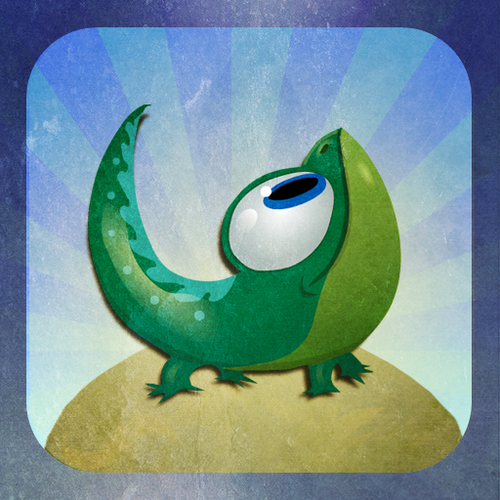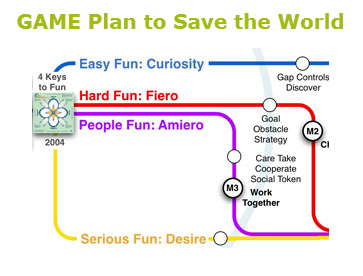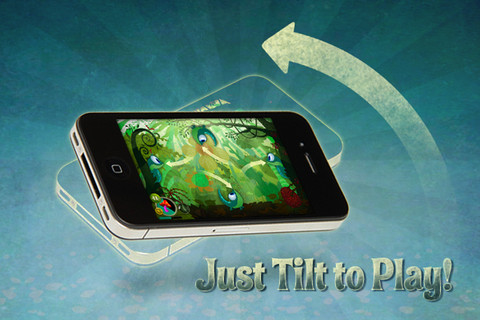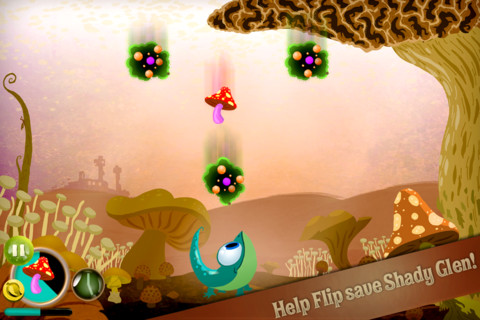Sept. 2, 2016 Update Adding a few recent finds along these lines of ‘putting emotion into game play’ like “Shelter, Paws” and other empathy based critter care games to edge towards seeding compassion for all creatures great and small caring for wolf pups and badger babies, instead of fantasy Pokemon Go creations. Also, here’s a recently funded Kickstarter called Junior Explorers, encouraging kids to love wildlife and nature and seed stewardship of the planet. Can we use online gaming to instill offline respect?
Worth a shot, given that we clearly need to get kids to empathize and relate to nature and wildlife rather than ‘selfie stick’ it to the creatures with zero regard for their well being. (AP notes humanity’s misguided National Parks interactions in their centennial observations.) MORE please!
 Original Post April 30, 2012 Today we have an interview with gaming guru Nicole Lazzaro of XEODesign to reinforce the positive use of screens in ‘gaming for good’ to induce real world change.
Original Post April 30, 2012 Today we have an interview with gaming guru Nicole Lazzaro of XEODesign to reinforce the positive use of screens in ‘gaming for good’ to induce real world change.
“Get ‘em outside,” is undeniably our clarion call for more outdoor, unstructured play time, especially with new preschool studies in Archives of Pediatrics & Adolescent Medicine showing over half of preschoolers 3-5 are NOT being taken outside daily…But this special interview with Nicole Lazzaro is a perfect example of why it’s imperative to view all screen time as an issue of lifestyle balance, dismissing any ‘vilification’ of media technology in simplistic either/or thinking to tap into the best of ALL worlds by figuring out what even MAKES something fun.
Recently named one of Forbes top 10 women in gaming, (and FastCompany most influential, and Gamasutra Top 20 and Fora.tv best of gamification etc.) Nicole Lazzaro is also founder and passionista behind newly launched Tilt World the eco-fun climate change game that’s a featured kids game on Apple’s iTunes this week. Little Flip the tadpole is showing families across the globe how to rbbbbbtt some informal learning into the education mix, leap into gaming fun, and maybe tongue zap a few of those ‘Angry Bird’ gamers towards more substantive content with a real world twist.
As the designer of the iPhone’s first accelerometer game, Nicole has pioneered possibility for over two decades with her well-known “4 Keys to Fun research” guiding hundreds of thousands of game developers worldwide to improve millions of player experiences.
Her research involved watching and gauging emotion on player’s faces, understanding the core four engagement practices that comprise “fun” as they translated into:
1.) the challenge of “Hard Fun”
2.) the novelty of “Easy Fun”
3.) friendship from “People Fun”
4.) meaningfulness through “Serious Fun”
If you ask Nicole how these “4 Keys of Fun”(great slideshare.net series) apply to classic outdoor play vs screens, she might slam dunk a basketball analogy to explain how “fun” plays out on the court…There’s the way it engages players with the novelty of bouncing a ball, the challenge of getting it into a hoop, the connection of playing with friends, and the value from a good work out.
Long before our current screen-focused era of points, badges, and gamification, Nicole’s company XEODesign was exploring the fun of games to improve the quality of lives. (Two of my own favorites in the ‘serious games/hard fun’ category are allies in health, with HopeLab’s ReMission and Playnormous’ Escape from Diab both which I’ve written about previously in the Power of Play health series (Pt 1 and Pt2 here)
 She explained how just eight years ago games were mostly focused on “Hard Fun” in the glow of light from a console in a basement stereotype that many mistakenly STILL view as the detached screen scene.
She explained how just eight years ago games were mostly focused on “Hard Fun” in the glow of light from a console in a basement stereotype that many mistakenly STILL view as the detached screen scene.
In actuality, it’s morphed into an entirely different opportunity, from exercise and education to using game mechanics to impart “easy fun and people fun” with leaders like Nintendo’s Wii, Microsoft’s Kinect, and industry giants like Zynga’s Farmville…and she believes the industry is currently undergoing the next transition into “Serious Fun.”
“Companies around the world are scrambling to figure out how to add Serious Fun to business replacing social media (People Fun) as the next marketing frontier. Educators are scrambling to add games to curriculum,” Lazzaro explains.
Here’s her slideshare presention channel about the 4 Keys to Fun to add context to this interview about where we’ve been and where we’re going in terms of the vast potential to unearth some new ways of thinking to bridge on and off screen with games and play. (a great example is my Shaping Youth interview with 11 year old Rylan on the experiential STEM program, “Vanished” from MIT/Smithsonian that engages kids with real life scientists amidst a platform of storytelling, collaborative play, and eco education–very cool use of all four keys to fun!)
Amy Jussel, Shaping Youth: Last month you spoke about “Winning Behavior-Change, Game Design & Engagement” with a record-breaking 22,500 attendees at the Game Developers Conference (I’d love to see how we can “drive behavior change” away from the number one killer of teens, texting while driving in cars!) and in June you’re on a panel at the 2012 Gamification Summit that could get lively, given your cautionary cues on the trend-tracking of gaming/gambling…So:
Tell us about what’s new and noteworthy, what parents should be watching for in behavioral pros and cons…What’s coming across the transom in this growth category-Give us a heads up!
Nicole Lazzaro, XEODesign: The emerging trend that concerns me the most is the current enthusiasm many have for casino gaming as the next big opportunity. There will be a push this year to legalize online gambling here in the United States. This poses a real risk for people who could become addicted and adversely affected financially.
As a designer, I also feel it is a thin form of engagement. Legalized online gambling could have a chilling effect on the creativity in games. If games offer the promise of paying the player to play (winning a jackpot) then less time will be spent on creating ways to make the experience fun. And making things fun is what my two companies XEODesign and XEOPlay are all about. I share a lot of research to the public to inspire the development of new types of games that go beyond stimulus response and reward tables. In the end Skinner boxes and slot machines are not that fun.
Amy Jussel, Shaping Youth: Removing gambling from the mix, on a macro level, where do you feel Corporate Social Responsibility ends and commercialism and brand-washing begin? Is there a way pro- social or education-driven games can ethically align with brands without exploitively commodifying the gaming experience or end user?
Nicole Lazarro, XEODesign: It’s a magical time to be making games. Games are the medium of the 21st century and just like any other communication medium they can be used to help people improve their lives or they can be used in other ways. Having multiple voices and an open market is important here. Also important is designing player experiences that evoke a wide range of emotional responses and not just addictive reward mechanics.
My interest is all about creating experiences that empower players to change the world.
According to M2 research there are over 350M mobile game players and will be 600M in 2014. This represents $5.4 Million in revenue that will double in three years. That’s a lot of people, time and money that could fuel solving the world’s problems.
Our family of game players is ready and waiting for the right kind of game. Play’s potential to change ourselves and our world is just in its infancy. The opportunity comes from what I call Serious Fun. By getting enough people engaged in Serious Fun we actually solve problems through direct action in the real world with a game.
Amy Jussel, Shaping Youth: You’ve called this “play sourcing” could you explain what that means? I’ve heard of crowd-sourcing and crowd-funding but play-sourcing is a new one!
 (visual at left as featured in iTunes)
(visual at left as featured in iTunes)
Nicole Lazzaro, XEODesign: Playsourcing is when play is used as the source of human motivation to change the player, their friends, and the real world.
For example… our newest proof of concept, Tilt World.com, is a game that launched on Earth Day. It’s on the front page of iTunes right now and we’re really excited about it because it’s raising awareness about eco climate games but it’s also a fun, beautiful game that unlocks human potential through play…
In Tilt World, players control Flip, a determined tadpole, who is on a mission to replant an entire forest that is being deforested by a toxic green Blight. Players tilt together and dedicate their points to WeForest who, once the goal is reached, will plant up to 1 million trees in Madagascar.
It’s a way of using the fun of games to improve the quality of our lives. What we are really talking about is the playsourcing movement, to give players an experience of hope that would empower them to new ways to solve old problems and do it in a way where they could see progress from space using Google Earth, and satellite images directly.
Amy Jussel, Shaping Youth: Sounds like a game parents might WANT their kids to play to ‘level up’ from flinging pigs and Angry Birds to layer in meaning vs addictive play. Along those lines, what do you think of partnerships that merge popular gaming platforms like Angry Birds with cause-marketing/prosocial platforms like MTV’s A Thin Line in their new anti-bullying Angry Birds/Thin Line partnership?Do you feel this is ideal to scale if done well or too much/alteration of game play?
Do you have any ‘next steps’ or ideation for embedding good causes with game play that would be a natural fit? (like maybe a Farmville w/organics/nutrition, Words w/Friends as relationship aggression intervention of how words can harm, etc)
Why do you think TiltWorld will have a chance to engage and inspire change when kids virtual worlds that tried this did not? e.g. Dizzywood planting seeds online to make a difference offline, or Elf Island/Xeko partnering with amazing animal/eco causes that went big with traction and then ran out of funding support, forced to taper off…
(NEWSFLASH! Breaking!! As of tonight it looks like Xeko.com may be resurrecting and partnering Gaming for Good with Oomba?? Just received this notice Fingers crossed, as I loved their creativity, positivity and purpose)
Nicole Lazzaro, XEODesign: I think that due to the time commitment involved, there can really only be one or two massive virtual worlds (e.g. Club Penguin etc) that “everyone” is playing. Most virtual worlds require longer play sessions to get the most out of them. On the other hand everyone can find 30 seconds to a few minutes to play a mobile game. The short play session helps make mobile games go viral and reach more players.
We absolutely believe in the potential for Tilt World to reach a large audience. I just returned from the Digital Kids Conference and the issue on top of all App developers was discoverability. Getting the App in front of a large number of players is extremely hard. A major brand can hit the top 10 on name recognition alone, but won’t stay there if the game play is not fun.
It’s important to remember that there is no such thing as an “Educational Game.” All games teach. That’s the Serious Fun aspect of play. The challenge for games that improve players is simply designing game play that’s fun. Most games that focus on “education” forget that player experiences are fun. A game that is fun, short, and enriching will take off like wildfire on mobile.
Amy Jussel, Shaping Youth:What was your thought process in designing TiltWorld, and how does the game actually work in the “Play a game and plant trees!” message? Marketing wise, how will it stand out in the sea of kids apps and digital offerings?
For starters, tomorrow, May 1, 2012, we’re having a “Friends of @TiltWorld On Twitter FREE DOWNLOAD from 12-3pm PDT so tell everyone you know!
But yes you’re right, it IS hard to break through with worthy content…so it’s important that sites like yours are pointing to it, as we have to SEE it before we can discover and explore fully.
I was thinking of these possibilities one day when suddenly it occurred to me. Why not build a game where player’s points planted trees? Imagine if all those points had a purpose, a direct impact on the real world…
It happened as I was playing with Google Earth trying to find a certain temple in Egypt when I pulled back and saw this little island off the coast of Africa. Zooming in, the topsoil erosion was so bad that it appears to be bleeding into the Indian Ocean. Try this yourself and you’ll see deforestation is real.
We didn’t want just “awareness” though…I wanted people to take action. Somehow or other we’ve cut down 600 billion trees. To put this into perspective each of us has 150 trees, 100 of them are gone, there are only 50 left. The only way I could think to give people hope and inspire them to new creative solutions is have players plant virtual seeds and the result would be real world trees… And do this in such a way that you could see progress from space.
Gamification is about awareness. Playsourcing motivates action. (puts ambitions into action)
Replacing these trees to reverse climate change is a challenge larger than any government can take on. Buying that many trees would break the World Bank. It would take an army of millions to take on this reforestation challenge. The only way to get that kind of planting is to make it voluntary and make it fun.
Again, it’s important to use the tools and technology as a “show and tell” …Madagascar is bleeding. And players can help seal the wound.
Amy Jussel, Shaping Youth: Could Tilt World and Flip the frog have a home in schools? Is this a missed bioscience opportunity for education? A possibility for after-school programs, online to offline outdoor play/nature discovery?
Nicole Lazzaro, XEODesign: Absolutely. It just takes a commitment by designers to do so. We also need a way to make it easier to discover these gems by schools. Major brands can help by hiring small indie studios to make games that have meaning. In my experience a small teams are more likely innovate than large teams.
Tilt World is a perfect addition to any science curriculum. That’s why we offer through Apple an educational discount. A lot of thought went into designing each area of Shady Glen that Flip rescues. Each scene focuses on a different stage of reforestation such as using mushrooms to detoxify the soil and then planting grasses to hold the soil in place. The game can be a spring board of discussions about the environment. Kids will play games anyway. Tilt World is a game that parents can feel good about because of the values it contains.
Tilt World makes it easy for students to experience ecological recovery of a desolate wasteland. By making it fun rather than preachy we spark interest and spark players imaginations. In the final phases of the game our Eco-Hero Flip designs and builds eco-mechanica (a machine that improves the environment instead of outputting waste); which we hope will inspire young inventors to create their own solutions to environmental issues.
Amy Jussel, Shaping Youth: Thanks for your time Nicole, it’s exciting to see how we can use ‘screens’ in fresh new ways to renew and replenish the outdoors, protect the planet, and get outside and PLAY to discover REAL frogs like Flip…
Great job on launch week, and readers, snag that app for free tomorrow with her ‘Friends and Family’ offer 12-3pm Pacific time, May 1st! I’ll ‘tweet it out’ before going dark for Screen Free Week. See you all next week!
Readers, for related kids sites and great educational programs like Cool The Earth.org (wow, I could envision a great partnership/pilot program with TiltWorld) and for more fun ways to impart environmental education, here’s a 40 link roundup of Earth and Eco interactive fun worth “recycling” to your friends.
Tilt World Trailer (warning, an auto start clip, so adjust volume if you’re at work or in class!)
Putting Emotion Into Play: Gaming/Thoughts From XEODesign
Why We Play Games: 4 Keys to More Emotion (download pdf)
What Makes a Game Fun (video of Nicole Lazzaro on BigThink)
New 4 Keys to Fun Poster Here
XEO GAME Plan to Save the World
XEO GAME Plan Example
XEO Chasing Wonder Map
Related Reading on Shaping Youth/STEM Specific
Vanished EduGame: MIT Goes “Back to the Future” with a STEM hit (11y.o Rylan reports)
Power of Play Series Pt1: Play WORKS!
Power of Play Series Pt2: AHA & Nintendo Teams for Innovation to Get Kids Moving
Power of Play Pt3: Active Video Games in Schools?
Starting from Scratch: Making STEM Easy, Kid-Friendly & Fun
Wise Women & Alice 3.0: Geek Chic For Girls (pt.1)
BrainCake: Teen Girls Talk Tech & Worldchanging (pt.2)
DigiGirlz: Teen Girls Build Community Online & Off (pt.3)
Shaping Youth Sponsors She’s Geeky: WIT & Wisdom Flourish
Project Raceway: ShopGirls Build STEM Eco-Marathon Car
She’s Geeky: Techno Leaders Converge
She’s Geeky:Vlogging with Ryanne Hodson at She’s Geeky
Media Moms, Engineers, Purple Tornadoes At She’s Geeky
She’s Geeky and Proud of It (My first Shaping Youth geekery)
Misguided Media: Space station takes a backseat to Britney?
Kids Online UNconference: Kaliya Hamlin, Joi Podgorny
Shaping Youth Interviews Girl Mogul Founder/Geek Chic
Related Games For Good/Eco Kids/ Shaping Youth
40 SY eco posts worth recycling
Inspiring Kids As Stewards of the Planet
Inspiring Kids With Green Media
Nature Rocks: Reconnecting Families with Planet Earth!
Nim’s Island: Shaping Youth Through Imagination & Adventure
Xeko/Elf Island: A Virtual World To Be Wild About
Xeko/Elf Island GoodQuest to Help Polar Bears
If Kids Could Be Dolphins: The Power of Creative Play
Greentrepreneurs: Recycle Bank Shows Kids it Pays to Be Green
S.F. Oil Spill Prompts Altruism & Activism in Kids
Kids Bring Home the Message to Cool the Earth
Digital Activism: Kids Stump for Change (World Wildlife Fund)
When Art Meets Earth: Wyland’s Murals Inspire Kids to Care
Shaping Youth Joins Eco-Literacy Coalition: NCLI
More in Shaping Youth’s EcoKids/Environment Archives Here…
Inspire Kids With Green Media: Kid-Vid & Games Galore
Nim’s Island: Shaping Youth Through Imagination & Adventure
Kids Plant Virtually Trees to Benefit Real Trees in Dizzywood
Seeding Virtual Worlds: Kids Going Green in Dizzywood
When Green Gets Jaded: Marketing Hope to Kids
Planting Earthseeds Via The Magic School Bus: Eco-Media For Kids











Nice post I agree with you that games are the medium of the 21st century and just like any other communication medium they can be used to help people improve their lives or they can be used in other ways.
This is an awesome sharing. Also i have learn many important matters about putting emotion in the game play.
I am pretty sure that my friends do also like it, I’ll be pinning it…